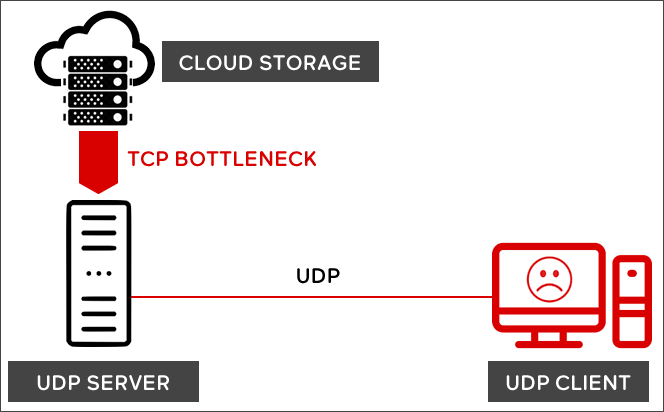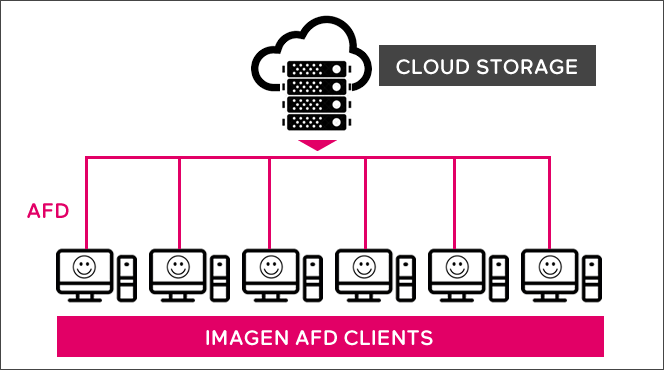Advances in IP based workflows and production have revolutionised content creation, but one key aspect of the content supply chain remains problematic. Sending large, production quality assets over long distances via public or private internet connections is still a huge challenge due to the constantly increasing file sizes used in media production.
A perfect storm of increased demand for high-resolution video, congested networks and challenging production schedules can make file delivery a painful, protracted experience. While you’re waiting for your file to download, read this.
Why do I need to accelerate the delivery of my files anyway?
Conventional methods of downloading video have hit a limit and the reason for that is TCP (Transmission Control Protocol).
TCP is one of the core pillars of the internet and networking in general. It’s old, general-purpose and robust. It’s everywhere, underpinning higher-level protocols that you will be familiar with like SMTP (for email), HTTP, HTTPS, FTP and many more.
TCP’s strength is that it enables reliable communication; the sender of a message knows when it’s been received. It has resilience built-in; TCP works hard to retransmit the parts that go missing and makes the internet’s unreliable interconnection of pipes appear reliable. This is incredibly useful when sending or receiving content, be it web pages or your shiny new 40GB video production. After all, you want to be sure it’s not corrupted in transit. TCP has your back.
So what’s the catch? Well, TCP’s reliability comes at a cost, one which becomes more apparent as the size of the data being transferred increases. The internet and TCP work in packets – relatively small chunks of data that need to be strung together to represent large files. TCP gets its reliability by having the receiver acknowledge receipt of those packets. That means that even when you are sending just one file (uploading or downloading – direction does not matter), there are lots of packets flying back and forth between the sender and the receiver.
Those packets take time to travel. The further away the recipient, the longer the round trip takes. This is called latency and in high-bandwidth high-latency environments, it makes any file transfer protocol using TCP less likely to be able to utilise all your available bandwidth.
That’s what file acceleration technologies fix and without it, large master or production quality files can take many hours or even days to transfer.
So you need file acceleration
Ok, you get it. Big files over long distance in shortest possible time demands file acceleration. There’s plenty a choice out there but the price tag can make your eyes water. But that’s Ok; you’ve wisely decided to save precious dollars using cloud storage to host your content – affordable, convenient and easy to access. Great move. Let’s just hook up your file acceleration software to the cloud storage account and you’re back on track right? Er not necessarily.
Does your file acceleration software work with cloud storage?
Most file acceleration technologies use UDP (User Datagram Protocol) rather than TCP. UDP is simpler than TCP because it dispenses with all that complex reliability stuff. It’s only faster because there are no built-in acknowledgments. To make it reliable again, most vendors roll their own protocol on top of UDP (or in an additional TCP side channel) which adds back error detection, correction and retransmission.
They just do these less frequently and on bigger chunks of data than TCP does to try and mitigate the latency issue. The catch here is that they are proprietary protocols and both the sender and the receiver need to be talking the same protocol for it to work. You can easily control both ends in some situations, such as simple file transfer between two locations when files are stored on local storage/on-premises. Like this:

In the cloud though, most storage does not natively talk to any of these proprietary UDP based protocols. Just like AWS’s S3 and Azure’s Blob storage, they use HTTP or HTTPS which is, of course, over TCP and an open standard. To get UDP access to those types of storage you could put a server in the cloud, or buy in a service, that fronts the cloud storage with your chosen UDP file acceleration software, but it adds complexity, cost and the extra hop causes another delay.

Also, if you start to scale up the number of people making requests for content, the UDP server can’t always cope with the extra demand. This can only be alleviated with significant investment in more hardware, even more expensive UDP server licenses and complex configuration.
At Imagen we do it differently (better).
Imagen’s Accelerated File Delivery has been specifically designed to connect directly to HTTP and HTTPS sources, so it works natively with public cloud storage accounts (like Azure Blobs or AWS S3) where your large files are stored. It applies acceleration to file transfers for any number of client connections requesting content, the scalability is derived from the cloud storage vendor so is transparently elastic. No need for extra hardware, software licenses, complex configurations – and no bottlenecks – just happy customers getting a great service and their files quickly from your Imagen hosted content management platform.

When Imagen manages your video library, your clients can search large collections of broadcast-ready content through a fully branded web portal. With AFD they also have the power to manage their own high-speed file deliveries from any Imagen platform. That means more choice, faster downloads and a great user experience designed to maximize consumption of your valuable content.
Find out more about Imagen Accelerated File Delivery.

Three scenarios where file acceleration is vital:
- Sports Broadcasting
TV production teams around the world need the latest sports highlights post-event. They demand fast access to broadcast quality assets but also additional content such as interviews, behind the scenes footage, idents, archive and more. - Media and Entertainment
A production company working on location overseas needs to send daily rushes back to Execs based in London and LA for review and approval. - Business and Enterprise
An auto manufacturer needs to deliver broadcast-quality promotional content to newsrooms worldwide as part of a global PR campaign to launch a new vehicle. The production team is only just still finishing the final edit – but the video needs to be with TV stations around the world in the next couple of hours.
Imagen AFD in action
Find out how IMG Replay use AFD to deliver exclusive sports content to a worldwide customer base.



